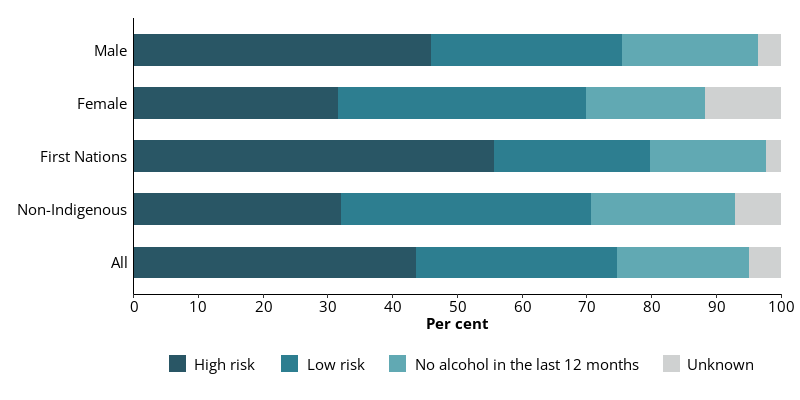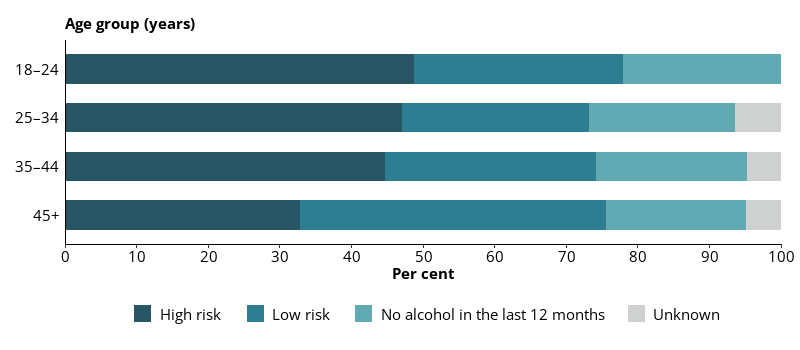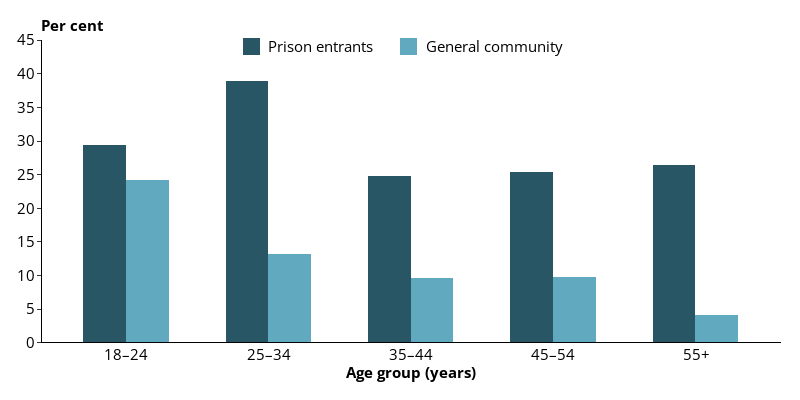Alcohol consumption
Alcohol use, particularly high-level consumption, is a major risk factor for death and disease and has been linked to numerous acute and chronic health conditions (GBD 2016 Alcohol Collaborators 2018). The consumption of alcohol also carries short-term risks of injuries and motor vehicle accidents due to intoxication (AIHW 2023).
There are strong and persistent links between alcohol use disorder and adverse psychosocial outcomes affecting physical and mental health, family violence, relationship instability, at-risk sexual behaviours, unemployment, violence, victimisation and criminal activity (Fergusson et al. 2013).
Alcohol consumption among prison entrants
The proportion of prison entrants who were at risk of alcohol-related harm over the previous 12 months was determined using questions on alcohol consumption from the World Health Organization’s Alcohol Use Disorder Identification Test (AUDIT-C) screening instrument (Babor et al. 2001). The AUDIT-C is a screening tool only and is not used for diagnostics. Further, the AUDIT-C relies on self-reported personal estimates of alcohol intake, which are often lower than the actual number of standard drinks consumed, meaning underestimation of alcohol-related risk is common (Devos-Comby and Lange 2008; Gilligan et al. 2019).
The AUDIT-C alcohol harm risk profile does not align with the National Health and Medical Research Council’s Australian guidelines to reduce health risks from drinking alcohol (the standard alcohol risk rating used in Australia) (NHMRC 2020). However, both guidelines recognise that alcohol-related harm can be caused by different patterns of consumption, such as from a single episode of consumption, or a cumulative effect often referred to as ‘lifetime risk’ (Babor et al. 2001; NHMRC 2020).
The AUDIT-C measures alcohol-related harm through a 12-point scoring system. A person is considered ‘high-risk’ if they score 6 points or more (Babor et al. 2001).
About 2 in 5 (44%) prison entrants were considered to be at high risk of alcohol-related harm during the previous 12 months (Indicator 2.2.1).
Almost a half (46%) of male prison entrants and about one-third (32%) of female prison entrants were considered to be at high risk of alcohol-related harm.
Of 183 First Nations prison entrants, 56% were considered to be at high risk of alcohol‑related harm, 24% were considered to be at low-risk and 18% reported no alcohol use in the last 12 months. Of 184 non-Indigenous prison entrants, 32% were considered to be at high risk of alcohol-related harm, 39% were considered to be at low-risk and 22% reported no alcohol use in the last 12 months (Figure 9.1).
Figure 9.1: Prison entrants, risk of alcohol-related harm in the previous 12 months, by sex and Indigenous identity, 2022

Notes
- Proportions are representative of this data collection only, and not the entire prison population.
- Excludes Victoria, which did not provide data for this item.
Source: Entrants form, 2022 NPHDC.
Prison entrants aged 18–24 (49%) were the most likely to be identified in the AUDIT-C as being at high risk of alcohol-related harm, and those aged over 45 (33%) were the least likely (Figure 9.2).
Figure 9.2: Prison entrants, risk of alcohol-related harm in the previous 12 months, by age, 2022

Notes
- Proportions are representative of this data collection only, and not the entire prison population.
- Excludes Victoria, which did not provide data for this item.
Source: Entrants form, 2022 NPHDC.
Alcohol consumption among prison dischargees
Prison dischargees were asked whether they consumed alcohol while in prison. Of 431 dischargees, 8.6% reported that they drank alcohol in prison while 91% reported they did not.
Alcohol consumption comparisons with general community
The proportion of prison entrants who had consumed at least one standard drink of alcohol in the previous 12 months were compared with that for people aged 18 and over in the AIHW’s 2019 National Drug Strategy Household Survey. The proportion of prison entrants who consumed alcohol was similar to that in the general community, with 76% of prison entrants consuming at least one standard drink of alcohol in the previous year, compared with 79% of people age 18 and over in the general community.
Comparisons were made between prison entrants and people in the community who reported consuming at least 7 standard drinks on a typical day of drinking in the previous 12 months, by age and sex. For each age group, prison entrants were more likely to drink 7 standard drinks on a typical day of drinking than people of the same age in the community (Figure 9.3).
The likelihood of consuming at least 7 standard drinks on a typical day of drinking decreased with age for people in the general community – from 24% of those aged 18–24 to 9.6% of those aged 35–44. Among prison entrants, the proportion who consumed 7 standard drinks per day of drinking remained high across all age groups (between 25–39%) (Figure 9.3).
Figure 9.3: Prison entrants (2022) and the general community (2019), self-reported consumption of at least 7 standard drinks on a typical day of drinking in the previous 12 months, by age

Notes
- Excludes those who reported not drinking in the previous 12 months.
- Proportions are representative of this data collection only, and not the entire prison population.
- Prison entrants excludes Victoria, which did not provide data for this item.
Sources: AIHW 2020; Entrants form, 2022 NPHDC.
AIHW (Australian Institute of Health and Welfare) (2020) National Drug Strategy Household Survey 2019, AIHW website, accessed 24 April 2023, doi:10.25816/e42p-a447.
—— (2023) Alcohol, tobacco & other drugs in Australia, AIHW website, accessed 12 July 2023.
Babor TF, Higgins-Biddle JC, Saunders JB and Monteiro MG (2001) ‘AUDIT – the Alcohol Use Disorders Identification Test’, Guidelines for use in primary care, 2nd edn, World Health Organization, Geneva.
Devos-Comby L and Lange JE (2008) ‘“My drink is larger than yours”? A literature review of self-defined drink sizes and standard drinks’, Current Drug Abuse Reviews,
1(2):162–176, doi:10.2174/1874473710801020162.
Fergusson DM, Boden JM and Horwood LJ (2013) ‘Alcohol misuse and psychosocial outcomes in young adulthood: results from a longitudinal birth cohort studied to age 30’, Drug and Alcohol Dependence 133:513–519.
GBD 2016 Alcohol Collaborators (2018) ‘Alcohol use and burden for 195 countries and territories 1990–2016: a systematic analysis for the Global Burden of Disease Study 2016’, The Lancet, 392:1015–1035.
Gilligan C, Anderson KG, Ladd BO, Yong YM and David M (2019) ‘Inaccuracies in survey reporting of alcohol consumption’, BMC Public Health, 19(1639), doi:10.1186/s12889-019-7987-3.
National Health and Medical Research Council (NHMRC) (2020) Australian guidelines to reduce health risks from drinking alcohol, NHMRC, Canberra.


